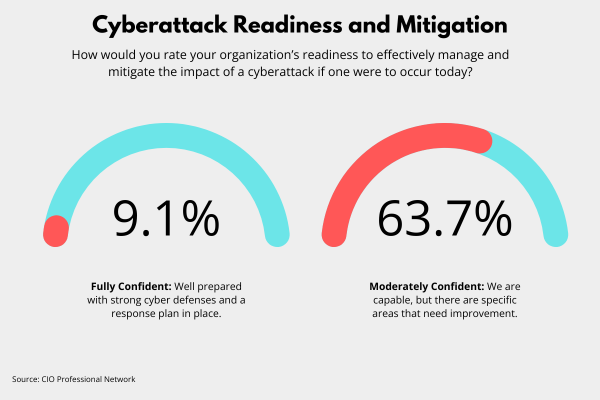As businesses increasingly rely on artificial intelligence and innovative software to increase productivity, one constant threat persists – cyberattacks. These attacks, employing a wide array of tactics, target both global and local entities across the private and public sectors, reinforcing the need for robust preparation, including detailed cybersecurity measures and resilience strategies.
The National CIO Review, in partnership with the CIO Professional Network, conducted a joint survey to assess how today’s technology leaders perceive their organizations’ preparedness and capability to manage and mitigate a potential cyberattack. The survey offers an eye-opening look into the varying degrees of confidence among technology leaders regarding their current cyber resilience.
Confidence Levels Among Technology Leaders
Unlike traditional cybersecurity, which primarily focuses on defense mechanisms, cyber resilience encompasses a broader strategy that includes preparation, recovery, and adaptation to new threats. Rather than attempting to establish your organization as “hack-proof”, cyber resilience is about recognizing that every system has vulnerabilities, preparing for the inevitable breach, and having an effective incident response plan that can be quickly implemented.
Despite the critical importance of cyber resilience, many technology leaders express significant concerns about their organizations’ preparedness. The survey revealed that only 9% of respondents were fully confident in their organization’s ability to manage and mitigate the impact of a cyberattack. In contrast, 18% of technology leaders felt generally confident, acknowledging their strong defenses but recognizing room for improvement.
A significant 64% of respondents expressed moderate confidence, indicating that while they believe their organizations are capable, there are specific areas needing enhancement. Interestingly, none of the respondents felt somewhat confident or not confident, highlighting a clear gap between moderate and high confidence levels. Additionally, 9% were unsure about their organization’s readiness, reflecting uncertainty in their current cybersecurity posture.

The Role of Leadership in Cyber Resilience
Leadership plays a pivotal role in fostering a culture of cyber resilience. Effective leaders understand that cybersecurity is not merely an IT issue but a critical business function impacting every aspect of the organization. However, engagement levels among senior executives also vary significantly.
A recent study by Commvault revealed that only 33% of CEOs or managing directors and 21% of other senior leaders are heavily involved in their companies’ cyber preparedness initiatives. This lack of engagement can lead to misalignment between IT operations and security operations teams, further complicating the organization’s ability to respond to cyber threats.
Technological and Human Elements
Cyber resilience requires a combination of advanced technological solutions and human expertise. While technologies like artificial intelligence and machine learning are crucial for swift threat detection and response, human insight is essential for contextualizing and interpreting these threats. This combination allows organizations to manage their specific risk profiles effectively.
Fostering a security-aware culture within the organization can be extremely beneficial. Regular training and awareness programs ensure that all employees, not just IT staff, understand their roles in maintaining cybersecurity.
Additionally, with ongoing collaboration between technology and human expertise, organizations can develop effective defense mechanisms capable of addressing complex cyber challenges, creating an adaptable security strategy that evolves with emerging threats.
The Wrap
To enhance cyber resilience, it is recommended that organizations adopt a proactive rather than reactive approach. This involves continuous education on emerging threats, investment in new technologies, and developing post-breach recovery strategies. Automation also plays a key role in faster threat detection, reducing the reliance on manual processes that can result in missed anomalies and successful attacks.
The survey findings underscore the need for technology leaders to increasingly prioritize their cyber preparedness and resilience. While a small group of respondents feel fully confident, the majority remain only moderately confident, indicating significant room for improvement.
While there is significant work to be done, technology leaders recognize that a cohesive strategy is needed to ensure their organizations are well-prepared to handle today’s evolving cyber threats. A strategic focus on leadership engagement, technological advancement, and fostering a security-aware culture has been shown to significantly boost an organization’s cyber resilience, and help technology leaders feel prepared and confident when the inevitable attack hits.







